Use of Newer Antifungal Therapies in Clinical Practice: What Do the Data Tell Us?
Considering the significant morbidity and mortality associated withinvasive fungal infections in immunocompromised patients, it is particularlyimportant to make the diagnosis as early as possible and tomake best use of the available antifungal drugs for prophylaxis andtreatment. The newer antifungal drugs include the lipid products ofamphotericin B, such as amphotericin B lipid complex (ABLC) andliposomal amphotericin B; voriconazole (a triazole); and caspofungin(an echinocandin). ABLC and liposomal amphotericin B are as effectiveas amphotericin B deoxycholate but are less nephrotoxic; ABLC isprobably the drug of choice for zygomycosis. Voriconazole is approvedfor use in the treatment of invasive aspergillosis and may have a role inpreventing breakthrough fungal infections in patients with persistentfever and neutropenia. Caspofungin is effective against both invasiveaspergillosis and invasive candidiasis.
ABSTRACT: Considering the significant morbidity and mortality associated withinvasive fungal infections in immunocompromised patients, it is particularlyimportant to make the diagnosis as early as possible and tomake best use of the available antifungal drugs for prophylaxis andtreatment. The newer antifungal drugs include the lipid products ofamphotericin B, such as amphotericin B lipid complex (ABLC) andliposomal amphotericin B; voriconazole (a triazole); and caspofungin(an echinocandin). ABLC and liposomal amphotericin B are as effectiveas amphotericin B deoxycholate but are less nephrotoxic; ABLC isprobably the drug of choice for zygomycosis. Voriconazole is approvedfor use in the treatment of invasive aspergillosis and may have a role inpreventing breakthrough fungal infections in patients with persistentfever and neutropenia. Caspofungin is effective against both invasiveaspergillosis and invasive candidiasis.The prevention and managementof invasive fungal infections areof enormous importance in thecare of patients undergoing cancerchemotherapy or bone marrow transplantation.Fungal infections such asinvasive aspergillosis and candidiasiscontinue to be important causes ofmortality in these patients. Key managementstrategies include accurateand rapid diagnosis, optimal use of antifungaldrugs for prophylaxis and empirictherapy, and, in select patients,additional interventions such asimmunomodulation therapies and surgery.This article will evaluate the newerantifungal agents, along with someagents that are still being investigated,for use in specific patient populationsand for management of specific mycoses.Although not uniformly successfulin every patient, these newagents nevertheless will have a verypositive impact on the management ofdifficult invasive mycoses.OverviewSome of the major developmentsin the treatment of invasive mycosescan be highlighted by a brief reviewof three landmark, evidence-basedstudies:
- Combination therapy for cryptococcalmeningitis: van der Horst etal[1] compared amphotericin B (0.7mg/kg/d) with a combination of amphotericinB and flucytosine (100 mg/kg/d) for the treatment of cryptococcalmeningitis in patients with AIDS.After 2 weeks of treatment, cerebrospinalfluid (CSF) cultures werenegative in 60% of those who receivedcombination therapy, compared with51% of those who received amphotericinB alone (P = .06).
- Voriconazole vs amphotericin Bfor invasive aspergillosis: Herbrechtet al[2] compared voriconazole at twodoses (6 mg/kg on day 1, followed by4 mg/kg twice daily) with amphotericinB deoxycholate (1 to 1.5 mg/kg/d)in patients with invasive aspergillosis.Successful outcomes were achieved in52.8% of the voriconazole group, comparedwith 31.6% of the amphotericinB group.
- Caspofungin vs amphotericin Bfor invasive candidiasis: Mora-Duarteet al[3] compared the echinocandincaspofungin with amphotericin B inpatients with invasive candidiasis. Ina secondary analysis, caspofungin'ssuccess rate was approximately 15%higher than the success rate for amphotericinB. In addition, caspofunginwas associated with a lower incidenceof adverse events.It is important to note that the treatmentsuccess rates achieved in theserobust, large, comparative studiesclearly do not approach 100% (Table1). Although the measurement of resultsin some clinical trials might bedebatable because treatment successwas based on specific study criteria,overall, the failure rates are still considerable,regardless of the clinicalcriteria used.
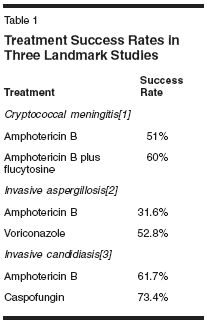
Diagnosis
Considering the significant morbidityand mortality associated with invasivefungal infections inimmunocompromised patients, it isparticularly important to diagnose afungal infection as early as possible.Unfortunately, the diagnosis is oftenchallenging. In invasive aspergillosis,for example, the signs and symptomsare nonspecific, and blood cultures arerarely positive.Although it is often difficult to obtainsamples for histopathology andculture, it is important to make everyattempt to identify the organism becausethe findings will influence treatment.The combination of histopathologyand culture is necessary becausethe results of one method might notbe definitive. For example, regardingthe technique of histopathology, thepresence of branching septae and hyphaecould indicate
Fusarium, Aspergillus,
or
Scedosporium
species,and only a culture would identify thecorrect pathogen.In addition, with histopathology,some patients may have conidia intissue that produce adventitial formsof
Fusarium, Acremonium,
and
Paecilomyces.
The histopathology reportmay indicate that one of thoseorganisms is the likely pathogen. Incontrast, the finding of conidia andhyphae in tissue is not seen with
Zygomycetes,Aspergillus fumigatus,
or
Aspergillus flavus.
Thus, the histopathologyresults can help complementculture results.Although there is no absolute proofthat early diagnosis results in less burdenof organisms, there is some evidencethat early diagnosis affects outcome.One study of patients with pulmonaryaspergillosis indicated thatmore frequent use of bronchoscopyand high-resolution CT led to a morerapid diagnosis and, therefore, earliertreatment.[4] The mortality rate was41% when the diagnosis was madewithin 10 days or less after the onsetof signs and symptoms, comparedwith 90% when the diagnosis wasmade after 10 days.CT scanning can be very useful inthe diagnosis of invasive pulmonaryaspergillosis. The most characteristicCT findings are the halo sign and aircrescentformation. The halo sign isvisualized as an area of low attenuationaround a nodule or pleural-basedlesion. Although these signs can occurin other diseases, they are highlysuggestive of invasive pulmonary aspergillosisin febrile neutropenic patients.The halo sign has a short duration;therefore, the use of early CT canbe quite valuable. A more nonspecificbut common finding is the presenceof nodular lesions on a CT scan; thishas less predictive value.
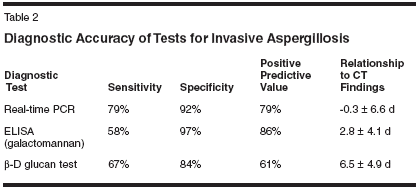
The diagnosis of invasive aspergillosiscan be confirmed by serologictests to detect circulating antigens,such as cell wall galactomannanand measurement of β-1,3-D glucanconcentrations. For example, Kami etal[5] evaluated the sensitivity andspecificity of real-time polymerasechain reaction (PCR), enzyme-linkedimmunosorbent assay (ELISA) forgalactomannan, and the β-D glucantest for the diagnosis of invasive aspergillosis(Table 2). The study included33 patients with invasive aspergillosisand 89 controls.The sensitivities and specificitiesranged from 58% to 79%, and 84% to97%, respectively.[5] Real-time PCRwas more sensitive than the other twotests; it was also highly specific for
Aspergillus
infection. This same studyalso evaluated the relationship betweentest results and CT findings.Positive findings on PCR precededthose of CT by -0.3 ± 6.6 days; thecorresponding figures were 2.8 ± 4.1days for ELISA and 6.5 ± 4.9 days forthe β-D glucan test.In high-risk patients, it is particularlyimportant to use every tool available-whether it is a serologic test orCT scan-to identify these invasivefungal infections as soon as possible.Often, CT scans show a small nodule,which the radiologist interprets as po-tentially being fungal-related. In thissituation, serologic findings could helpsupport the diagnosis of aspergillosis.Although these tests are not perfect,using a combination of them in highriskpatients may result in an earlierdiagnosis. The diagnosis of invasivecandidiasis could be improved by betterserologic tests, since at present,blood cultures are positive in only 50%to 60% of patients with invasive candidiasis.
Immunomodulation
Although immunomodulation hasbeen extensively studied at the basicscience level, clinically, its use has yetto be optimized. Some studies indicatethat immunomodulation therapiesdo not improve outcome inimmunocompromised patients. Forexample, a large, multicenter, EuropeanOrganization for Research onTreatment of Cancer (EORTC) studydemonstrated that the use of growthfactors-primarily granulocytecolony-stimulating factor (G-CSF)-had no impact on outcome in hematologypatients who had invasive aspergillosis.[6] This study included130 cases, 20 hospitals, and 8 countries.Safdar et al,[7] at the M. D. AndersonCancer Center, evaluated treatmentwith G-CSF-primed white bloodcells (WBCs), given every other day,in 29 patients with candidemia; 76%of the patients were neutropenic. Thecontrol group consisted of 441 cancerpatients with candidemia, 45% ofwhom were neutropenic. The associatedmortality was 48% in patientswho received WBC transfusions and45% in the control group. The authorssuggested that patients who receivedthe WBC transfusions may have hadworse prognostic factors than the controlpatients, and therefore, their comparablemortality may have actuallyrepresented a favorable response, butthis interpretation will require furthervalidation.
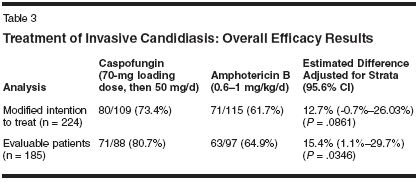
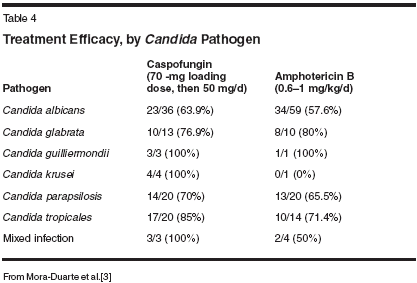
Another approach to immunomodulationinvolves immune reconstitution.In a study by Pappas and associates,[8] two doses of adjuvant recombinantinterferon-gamma weregiven to patients with cryptococcalmeningitis. A trend toward faster declinein CSF yeast counts was seen inthose patients who received the interferon,compared with those who receivedplacebo. It is likely that the resultswere not statistically significantbecause there were not enough patientsin the study. However, interferonmay be difficult to use in organ transplantrecipients because of the rejectionrisk to the transplanted organ.A word of caution: the use ofgrowth factors to treat pulmonary aspergillosishas the potential complicationof acute respiratory distress syndrome.This may be related to themassive amount of degranulation ofWBCs in the area of the infection.There is some evidence that boostingthe WBC count too fast is detrimental.For example, in a small study, theimmediate mortality rate was 50% inpatients who received G-CSF for aspergillosiswho had a rapid increasein WBC count (0 to 4,500/μL in lessthan 5 days), compared with 17% inthose who had a more gradual increasein WBC count.[9] It is clear that weneed further studies to optimize ouruse of immunomodulation as adjunctivetherapy for successful managementof fungal infections.
Antifungal Therapy: DrugRegimens or Prescriptions
A number of key questions remainabout antifungal drug regimens. Thefollowing is a representation of justsome of these questions:
- What is the best dosage for liposomalamphotericin B? Ruiz et al[10]retrospectively studied 13 patientswith proven, probable, or possible in-vasive aspergillosis. Four of the patientshad received prophylaxis withitraconazole, and eight had neutropenia.Treatment with 10 mg/kg/d of liposomalamphotericin B was successfulin 9 of 10 patients with proven orprobable disease, and none of the patientshad nephrotoxicity. This findingdoes not prove that 10 mg/kg/d is thebest dosage, but it suggests that thepossibility that the higher doses mightbe beneficial should be considered.
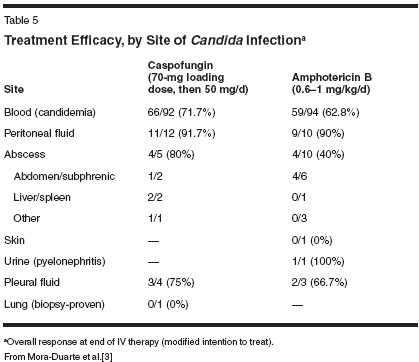
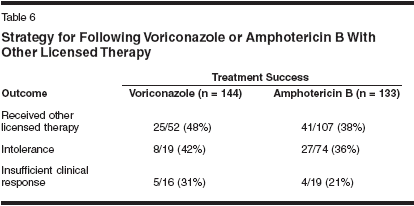
- Are the dosages of echinocandinstoo low? This is a concern, particularlyin neutropenic patients who have highrelapse rates of candidemia. Schranzet al[11] evaluated the efficacy of threedifferent doses of anidulafungin, aninvestigational glucan synthesisinhibitor, in the managementof candidemia. The success rate was72% for the lowest dose (100 mg loadingdose/50 mg daily dose), 87% forthe intermediate dose (150 mg/75 mg),and 87% for the highest dose (200mg/100 mg). This result may reflectdose-dependent efficacy.Echinocandins have dose-dependentkilling in vitro. In neutropenicpatients, the organisms have to bekilled primarily by the drug, becausethe host defense is limited. Since theechinocandins are relatively nontoxic,it is reasonable to ask whether we areunderdosing when we give 50 mg ofcaspofungin.
- Is there a role for the aerosolizedroute of administration? There is amoderate amount of experience withaerosolized amphotericin B lipid complex(ABLC). Pharmacokinetic datasuggest that the lipid formulations insuspension might be more effectivethan the deoxycholate preparation ofamphotericin B. Certainly, the lipidproducts are much easier to aerosolize.In an open trial in which 51 lungtransplant recipients received aerosolizedABLC, the incidence of toxicitywas less than 5%.[12] There wereno lung infections, two anastomosisinfections, and four extrapulmonaryinfections, which you might expect tooccur simply because this drug is notabsorbed into the systemic circulation.In a randomized double-blindstudy, 100 consecutive lung transplantrecipients were given aerosolizedABLC or aerosolized amphotericin Bdeoxycholate.[13] The incidence ofadverse events was lower in the ABLCgroup than in the amphotericin Bdeoxycholate group (13.7% vs 28.6%;P = .03). Failures of prophylaxis occurredin 11.8% of the ABLC groupand in 14.3% of the amphotericin Bdeoxycholate group.More studies are needed to determinewhether fungal infections in thelung can be prevented with minimalamounts of inhaled antifungal drug,particularly when the drug needs to begiven for long periods, as is the casewith bone marrow transplant (BMT)recipients.
- To what extent does the site ofinfection influence the efficacy ofspecific therapies? CNS fungal infectionsremain quite difficult to treat.Troke et al[14] reported a 34% completeor partial response rate in 86 patientswith CNS aspergillosis whowere given voriconazole. AmongBMT recipients, the success rate was15%, while among the other patients,the success rate was 42% to 50%.Scedosporium prolificans andScedosporium apiospermum can alsocause CNS infection; the latter is relativelysusceptible to voriconazole. Inone study, voriconazole was effectivein 7 out of 11 patients (64%) with Sapiospermum infection but failed in2 of 2 patients with S prolificans infection.Pitisuttithum et al[15] reported a40% success rate with posaconazolein patients with CNS fungal infections,such as those caused by Aspergillus,Scedosporium, Coccidioides immitis,Histoplasma capsulatum, black molds,and Zygomycetes. Posaconazole'ssuccess rate was 59% in patients withcryptococcal meningitis.
Surgery
The role of surgery for the managementof invasive fungal infectionsshould not be overlooked. Surgerydoes have a role in select patients withZygomycetes and black mold infectionsand in some patients with invasiveinfections with
Aspergillus
andother hyalohyphomycetes. Caillot etal[16] reported that combined medical-surgical therapy achieved a curerate of 84% in 25 neutropenic patientswho had surgically proven pulmonaryaspergillosis.Another study involved 87 patientswith hematologic malignancies inwhom invasive pulmonary aspergillosiswas suspected.[17] Of the 39 patientswho underwent resection on thebasis of CT findings, 35 actually hadinvasive pulmonary aspergillosis. The2-year survival rate was 36% in theresected group and 20% in theunresected group.Thus, there is evidence that in somecircumstances, surgery can have apositive outcome, although it is importantto note that these are very selectpatient populations regarding the abilityto tolerate surgery.
Antifungal Therapy: A Focus on the Newer Drugs
Invasive fungal infections continue to be a significant cause of morbidityand mortality among patients undergoing cancer chemotherapy or bone marrowor stem cell transplantation. The toxicity associated with amphotericin Bdeoxycholate and the incidence of treatment failures have led to the developmentof new antifungal drugs, such as the lipid formulations of amphotericinB, the triazoles, and the echinocandins.
Liposomal Amphotericin B
The lipid formulations of amphotericin B are approved for use in the treatmentof invasive fungal infections when amphotericin B deoxycholate fails orwhen it is associated with unacceptable toxicity. Liposomal amphotericin Bhas been reported to have an overall response rate of about 60% in this setting[46,47] and is associated with less nephrotoxicity than amphotericin Bdeoxycholate.[48,49]
Triazoles
Voriconazole is a broad-spectrum triazole with efficacy against invasive aspergillosis,[2,50] fluconazole-resistant candidiasis,[51] and a variety of othermycoses.[52] It is also effective in preventing breakthrough fungal infectionsin patients with fever and neutropenia. Voriconazole has been approved by theFDA for primary treatment of acute invasive aspergillosis and for salvage therapyfor serious infections caused by
Scedosporium apiospermum and Fusarium
species.Data from 85 patients who received voriconazole have been reviewed.[53]Approximately 50% of the patients were bone marrow transplant recipients,approximately 27% had aspergillosis, and 24% had neutropenia; 13% receivedcombination therapy. Within 72 hours of initiating voriconazole therapy, themost common drug interactions were with cyclosporin A (52%) and tacrolimus(29%); for both, the levels fell outside the therapeutic range. Liver function testresults were elevated in 10% of patients. Therefore, when using voriconazole,it is important to be aware of these drug interactions and to carefully considerthe cost-benefit ratio.
Echinocandins
The echinocandins include caspofungin, micafungin, and anidulafungin.These drugs are glucan synthesis inhibitors. Caspofungin is active against
Aspergillus
and
Candida
species, but it does not have significant activity against
Cryptococcus neoformans.
It has good in vitro activity against
Candida
species,including those resistant to fluconazole and itraconazole.[54,55]Caspofungin has been demonstrated to be effective in the treatment of oropharyngealand esophageal candidiasis,[56-58] fluconazole-resistant esophagealcandidiasis,[59] and invasive candidiasis.[3]Caspofungin is approved by the FDA for salvage therapy in patients withinvasive aspergillosis who have been refractory to or intolerant of amphotericinB, amphotericin B lipid complex, and/or itraconazole. It is also approvedfor the treatment of oropharyngeal and esophageal candidiasis and invasivecandidiasis. The standard dosage is 50 mg/d IV after a 70-mg loading dose;higher dosages (70 mg/d) have been safely used. The duration of treatmentdepends on the severity of the patient's underlying disease, recovery from immunosuppression,and clinical response. Caspofungin has an excellent safetyprofile and does not appear to be antagonistic when combined with other antifungaltherapies.[60]Micafungin is an investigational agent that has a broad spectrum of activityagainst
Candida
species[61] and
Aspergillus
species. Anidulafungin is also aninvestigational agent that is active against
Candida
species.[62,63]
Managing Specific Infections
Invasive Candidiasis
There are several evidence-basedtreatment strategies for candidemia.The early studies demonstrated that theeffectiveness of fluconazole is probablyequivalent to that of amphotericinB in most patients withcandidemia. Rex et al[18] reported asuccess rate of 79% with amphotericinB (0.5 to 0.6 mg/kg/d) and 70%with fluconazole (400 mg/d) in nonneutropenicpatients with candidemia;this difference was not statistically significant.Phillips et al[19] reportedsuccess rates of 62% with amphotericinB and 57% with fluconazole innon-neutropenic patients withcandidemia. These studies are limitedin their evaluation of
Candida
speciesother than
Candida albicans.

It is important to note, however, thatfluconazole has limited activity against
Candida krusei
and some strains of
Candida glabrata.
[20-24] While
Calbicans
has been the predominant
Candida
species, an increased incidenceof non-
albicans
species-including
C glabrata
and
C krusei
-hasbeen observed in many US hospitals.[25,26] Infections caused by non-
albicans
species are associated withincreased morbidity and mortality.[27]
- The role of caspofungin: A numberof studies have demonstrated thatcaspofungin is effective in the treatmentof invasive candidiasis (seesidebar). Colombo et al[28] comparedcaspofungin with amphotericin B in224 patients with invasive candidiasisin 20 countries and found that outcomeswere comparable with theseantifungal drugs (overall efficacy ratesof 74% and 62%, respectively).As noted above, a landmark studyof the treatment of invasive candidiasiswas reported by Mora-Duarte etal.[3] This randomized, double-blindstudy compared caspofungin (70-mgloading dose, followed by 50 mg/d)with amphotericin B deoxycholate(0.6 to 1 mg/kg/d) for invasive candidiasis.Only 10% of the patients hadneutropenia. The incidence ofendophthalmitis was 3.7%. In mostpatients, the central venous catheterwas changed within 72 hours.After 10 days of intravenoustherapy, there could be a step down tooral fluconazole (400 mg/d); thecourse of therapy was approximately2 weeks. Overall, there was no significantdifference in outcome. However,when the analysis focused on the 185patients who met prespecified criteriafor evaluation, the efficacy rate forcaspofungin was 80.7%, comparedwith 64.9% for amphotericin B (P =.03) (Table 3).[3] Table 4 shows theefficacy of these agents against differentCandida species. Caspofungin wasassociated with a lower incidence ofadverse events compared with amphotericinB.While this study primarily involvedpatients with candidemia, caspofunginwas also seen to be effective in patientswith Candida in peritoneal fluid andin those with Candida in abscesses ofthe abdomen, liver, or spleen (Table5). The efficacy of caspofungin and theother glucan synthesis inhibitorsagainst intra-abdominal Candida infectionsmay be particularly impressivein these sites.Recently, at Duke University MedicalCenter, there were 10 cases of intra-abdominal candidiasis that did notrespond to fluconazole or ABLC. Thespecific Candida species were Cglabrata (5), C albicans (3), C krusei(1), and Candida tropicalis (1). Theinfections included perinephritic abscess,peritonitis, cholangitis, and fluidcollection/abscess. All of these infectionswere successfully managed withcaspofungin (A. Zaas et al, unpublisheddata).
- Catheter removal: Although removalof catheters is considered thestandard of care in patients withcandidemia, there are some circumstancesin which this is very difficult.Nucci and Anaissie[29] reviewed theliterature and found that one studyshowed benefit of catheter removal,one showed no benefit, and two studiesfound marginal benefit of catheterremoval.
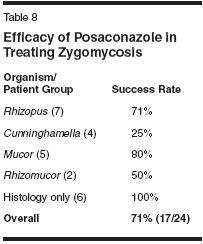
- Recent biofilm data suggest thatABLC and the echinocandins may beparticularly useful in treating invasivecandidiasis when it would be very difficultto remove the catheter.[30,31]These antifungals are more effectiveat killing Candida in biofilms than arethe azoles and amphotericin B deoxycholate.[30,31]
Invasive Aspergillosis
Herbrecht et al[2] compared intravenousvoriconazole (two doses of 6mg/kg on day 1, followed by 4 mg/kgtwice daily for at least 7 days) withamphotericin B deoxycholate (1 to 1.5mg/kg/d) in patients with invasive aspergillosis,most of whom were allogeneichematopoietic cell transplantrecipients. According to several differentcriteria, voriconazole was moreeffective than amphotericin B; successfuloutcomes were achieved in52.8% of the voriconazole group,compared with 31.6% of the amphotericinB group.A subsequent analysis focused onoutcomes of those patients who firstreceived voriconazole or amphotericinB and then received some otherantifungal therapy.[32] For those whofirst received voriconazole and thenreceived amphotericin B, there did notappear to be significant antagonism(Table 6). Patients who were switchedfrom amphotericin B to ABLC did nothave dramatically better outcomes, butsuccess occurred in 14 of 47 patients(30%).The authors concluded that thestrategy of following amphotericin Bdeoxycholate with another therapy,including ABLC, was less successfulthan initial therapy with voriconazole.The important message to be gainedfrom this study is that the best chancefor treatment success is most likelywith the initial treatment regimen.
Zygomycosis
Infections caused by Zygomycetesare being seen with increasingfrequency. Zygomycosis usuallyinvolves the rhino-facial-cranial areas,lungs, skin, or GI tract, but widelydisseminated infection can occur.[33]Rhinocerebral disease is the mostcommon form.[34] Pulmonary zygomycosisis less common and usuallypresents as rapidly progressingpneumonia. The risk factors forzygomycosis are diabetes, cancer, andtransplantation.Zygomycosis is one of the mostdifficult invasive fungal infections totreat. There is a three-part strategy formanagement: control of the underlyingdisease, surgical debridement, andmedical therapy. ABLC (5 mg/kg/d)is probably the drug of choice, becauseit is as effective as-or more effectivethan-amphotericin B deoxycholateand is associated with less nephrotoxicity.Larkin and Montero[35] studiedthe efficacy and safety of ABLC in 64patients with zygomycosis. The overallsuccess rate was 72%, and the successrate was 64% in patients with disseminateddisease (Table 7).Posaconazole may be an alternativetherapy, and there is some support forit from in vitro and animal model data.In a small study of 23 patients withzygomycosis, Greenberg et al[36]found a 71% success rate for treatmentwith posaconazole, and the drug waswell tolerated (Table 8). These resultsdo not prove that posaconazole is moreeffective than amphotericin B butrather suggest that it has potential useas an alternative therapy.
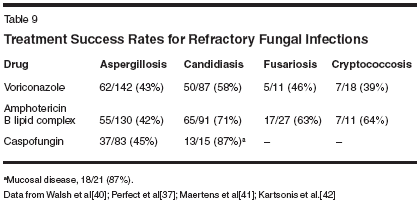
Phaeohyphomycosis
The combination of surgicaldebridement and therapy with anextended-spectrum triazole appears tobe effective in the treatment ofphaeohyphomycosis. In one study,voriconazole successfully managed12 of 12 black mold infections.[37]In a different study, 9 of 13 mycetomas-difficult chronic skin infections-were successfully managedwith posaconazole.[38] Finally, threeof five cases of
Wangiella
meningitis,which were associated with contaminatedcorticosteroids, were successfullytreated with voriconazole.[39]
Refractory Fungal Infections
The efficacy and safety ofvoriconazole as salvage therapy forpatients with refractory fungal infections,and as primary therapy forpatients with infections for whichthere is no approved therapy, havebeen evaluated.[37] Successful outcomeswere observed in 47% ofpatients with refractory infections andin 68% of those who had infectionswith no approved therapy. The efficacyrates were 43.7% for aspergillosis,57.5% for candidiasis, 38.9% forcryptococcosis, 45.5% for fusariosis,and 30% for scedosporiosis. Voriconazolewas well tolerated in thesepatients.Table 9 shows the success rates withvoriconazole, ABLC, and caspofunginin patients with refractory fungal disease.[37,40-42] In patients with aspergillosiswho have not responded totreatment (usually with amphotericinB), a 40% to 45% success rate can beachieved with another drug. Thesuccess rates are somewhat higher inpatients with candidiasis, withcaspofungin being the most effective(87%). To a certain extent, these findingsmay reflect the fact that thesepatients have been treated extensivelywith triazole compounds, and theremay be some cross-resistance betweenvoriconazole and fluconazole in certainpatient populations.Walsh et al[40] reviewed the efficacyand safety of ABLC in 556 casesof refractory invasive fungal infections.There was a complete or partialresponse in 42% of cases of aspergillosis,67% of cases of disseminated candidiasis,71% of cases of zygomycosis,and 82% of cases of fusariosis.
Drug Resistance
The emergence of resistance to antifungaldrugs is a significant concern.The mechanisms for fluconazole resistanceare understood, and in vitrosusceptibility testing has been standardized.At Duke University MedicalCenter, approximately 10% of selected
C albicans
isolates were foundto be resistant to fluconazole. Resistanceto flucytosine has also been observed,and this agent is rarely used asmonotherapy. Resistance to other antifungalagents has also been reported.For example:
- Caspofungin: Resistance tocaspofungin was reported in four patientswho received intermittentcaspofungin therapy for fluconazoleresistantesophageal candidiasis.[43]At my institution, breakthroughcandidemias have occurred in neutropenicpatients receiving caspofungin,perhaps because the optimal dosage isnot being used. We await studies withhigher doses. In vitro testing forcaspofungin resistance has not yetbeen standardized.
- Voriconazole: BreakthroughZygomycetes infections have beendocumented in patients receivingvoriconazole. In one report, breakthroughinfections were documentedin four hematopoietic stem celltransplant patients.[44] Breakthroughyeast infections with C glabrata andC krusei have also occurred withvoriconazole, and it is my opinion thatthey will occur more frequently.
- Amphotericin B: Polyene resistancehas been observed with Aspergillusterreus in animal models and invitro. In 87 cases of invasive infectioncaused by A terreus, it was found thatamphotericin B was not as effectivein treatment as voriconazole.[45]
Summary
The new antifungal drugs are outstandingand can have a significantimpact on the management of invasivefungal infections. We are still in theprocess of establishing determiningtheir optimal use; further studies areneeded to establish the best dosing,combinations, and timing of therapy.There are still questions about preciselywhen the glucan synthesis inhibitorsshould be used in aspergillosis.Should they be used after patientshave been treated extensively withanother drug or in the initial treatmentregimen?Amphotericin B deoxycholate isnow relegated to a minor use. Consideringits toxicity and the availabilityof effective and less toxic drugs, thereare few circumstances in which its usecan be justified. For instance, in treatmentof cryptococcal meningitis, amphotericinB deoxycholate is still appropriate.It is very important to try to preventfungal infections wheneverpossible and to make best use of thenew antifungal therapies. However, thepatient's underlying disease remainsthe major factor in determining clinicaloutcomes. Many treatment failuresare actually the result of the patient'sunderlying disease rather than thespecific fungal infection.
Disclosures:
Dr. Perfect has receivedresearch support from, acted as a consultant for,and served on speakers' bureaus for Merck,Pfizer, Enzon, PLIVA, Schering-Plough, andFujisawa.
References:
1.
van der Horst CM, Saag MS, Cloud GA,et al: Treatment of cryptococcal meningitis associatedwith the acquired immunodeficiencysyndrome. National Institute of Allergy andInfectious Diseases Mycoses Study Group andAIDS Clinical Trials Group. N Engl J Med337:15-21, 1997.
2.
Herbrecht R, Denning DW, Patterson TF,et al: Voriconazole versus amphotericin B forprimary therapy of invasive aspergillosis. NEngl J Med 347:408-415, 2002.
3.
Mora-Duarte J, Betts R, Rotstein C, et al:Comparison of caspofungin and amphotericinB for invasive candidiasis. N Engl J Med.2002;347:2020-2029.
4.
von Eiff M, Roos N, Schulten R, et al:Pulmonary aspergillosis: Early diagnosis improvessurvival. Respiration 62:341-347, 1995.
5.
Kami M, Fukui T, Ogawa S, et al: Use ofreal-time PCR on blood samples for diagnosisof invasive aspergillosis. Clin Infect Dis33:1504-1512, 2001.
6.
Denning DW, Marinus A, Cohen J, et al:An EORTC multicentre prospective survey ofinvasive aspergillosis in haematological patients:Diagnosis and therapeutic outcome.EORTC Invasive Fungal Infections CooperativeGroup. J Infect 37:173-180, 1998.
7.
Safdar A, Hanna HA, Boktour M, et al:Donor granulocyte transfusions in cancer patientswith hematogenous candidiasis: Impacton fungemia outcome. Presented at the 43rdInterscience Conference on AntimicrobialAgents and Chemotherapy; September 14-17,2003; Chicago. Abstract M-969.
8.
Pappas PG, Rex JH, Sobel JD, et al:Guidelines for treatment of candidiasis. ClinInfect Dis 38:161-189, 2004.
9.
Todeschini: Presentation at EMM Meetings,Barcelona, 2000.
10.
Ruiz I, Olive T, Gavalda J, et al: Highdoses of Ambisome in the treatment of invasiveaspergillosis (IA). Presented at the 43rdInterscience Conference on AntimicrobialAgents and Chemotherapy; September 14-17,2003; Chicago. Abstract M-966.
11.
Schranz JA, Krause D, Goldstein BP, etal: Efficacy of anidulafungin (ANID) for thetreatment of candidemia. Presented at the 43rdInterscience Conference on AntimicrobialAgents and Chemotherapy; September 14-17,2003; Chicago. Abstract M-971.
12.
Palmer SM, Drew RH, Whitehouse JD,et al: Safety of aerosolized amphotericin B lipidcomplex in lung transplant recipients. Transplantation72:545-548, 2001.
13.
Drew RH, Dodds Ashley E, BenjaminDK Jr, et al: Comparative safety of amphotericinB lipid complex and amphotericin B deoxycholateas aerosolized antifungal prophylaxisin lung-transplant recipients. Transplantation77:232-247, 2004.
14.
Troke PF, Schwartz S, Ruhnke M, et al:Voriconazole (VRC) therapy (Rx) in 86 patients(pts) with CNS aspergillosis (CNSA): A retrospectiveanalysis. Presented at the 43rdInterscience Conference on AntimicrobialAgents and Chemotherapy; September 14-17,2003; Chicago. Abstract M-1755.
15.
Pitisuttithum P, Gaona-Flores V, NegroniR, et al: Efficacy of posaconazole (POS) in treatmentof central nervous system (CNS) fungalinfections: Results of an open-label study. Presentedat the 43rd Interscience Conference onAntimicrobial Agents and Chemotherapy; September14-17, 2003; Chicago. Abstract M-978.
16.
Caillot D, Couaillier JF, Bernard A, etal: Increasing volume and changing characteristicsof invasive pulmonary aspergillosis onsequential thoracic computed tomographyscans in patients with neutropenia. J Clin Oncol19:253-259, 2001.
17.
Yeghen T, Kibbler CC, Prentice HG, etal: Management of invasive pulmonary aspergillosisin hematology patients: A review of87 consecutive cases at a single institution. ClinInfect Dis 31:859-868, 2000.
18.
Rex JH, Bennett JE, Sugar AM, et al: Arandomized trial comparing fluconazole withamphotericin B for the treatment of candidemiain patients without neutropenia. N Engl J Med331:1325-1330, 1994.
19.
Phillips P, Shafran S, Garber G, et al:Multicenter randomized trial of fluconazoleversus amphotericin B for treatment ofcandidemia in non-neutropenic patients. CanadianCandidemia Study Group. Eur J ClinMicrobiol Infect Dis 16:337-345, 1997.
20.
Rex JH, Rinaldi MG, Pfaller MA: Resistanceof Candida species to fluconazole.Antimicrob Agents Chemother 39:39:1-8, 1995.
21.
Pfaller MA, Jones RN, Doern GV, et al:Bloodstream infections due to Candida species:SENTRY antimicrobial surveillance programin North America and Latin America,1997-1998. Antimicrob Agents Chemother44:747-751, 2000.
22.
Yamamura DL, Rotstein C, Nicolle LE,et al: Candidemia at selected Canadian sites:Results from the Fungal Disease Registry,1992-1994. Can Med Assoc J 160:493-499,1999.
23.
Kao AS, Brandt ME, Pruitt WR, et al:The epidemiology of candidemia in two UnitedStates cities: Results of a population-based activesurveillance. Clin Infect Dis 29:1164-1170,1999.
24.
Pfaller MA, Jones RN, Doern GV, et al:International surveillance of blood stream infectionsdue to Candida species in the EuropeanSENTRY program: Species distributionand antifungal susceptibility including the investigationaltriazole and echinocandin agents.Diagn Microbiol Infect Dis 35:19-25, 1999.
25.
Wingard JR, Merz WG, Rinaldi MG, etal: Increase in Candida krusei infection amongpatients with bone marrow transplantation andneutropenia treated prophylactically withfluconazole. N Engl J Med 325:1274-1277,1991.
26.
Abi-Said D, Anaissie E, Uzun O, et al:The epidemiology of hematogenous candidiasiscaused by different Candida species. ClinInfect Dis 24:1122-1128, 1997.
27.
Viscoli C, Girmenia C, Marinus A, et al:Candidemia in cancer patients: A prospective,multicenter surveillance study by the InvasiveFungal Infection Group (IFIG) of the EuropeanOrganization for Research and Treatment ofCancer (EORTC). Clin Infect Dis 28:1071-1079, 1999.
28.
Colombo AL, Perfect J, DiNubile M, etal: Global distribution and outcomes forCandida species causing invasive candidiasis:Results from an international randomizeddouble-blind study of caspofungin versusamphotericin B for the treatment of invasivecandidiasis. Eur J Clin Microbiol InfectDis 22:470-474, 2003.
29.
Nucci M, Anaissie E: Should vascularcatheters be removed from all patients withcandidemia? An evidence-based review. ClinInfect Dis 34:591-599, 2002.
30.
Kuhn DM, George T, Chandra J, et al:Antifungal susceptibility of Candida biofilms:Unique efficacy of amphotericin B lipid formulationsand echinocandins. AntimicrobAgents Chemother 46:1773-1780, 2002.
31.
Ramage G, Vandewalle K, Bachmann SP,et al: In vitro pharmacodynamic properties ofthree antifungal agents against preformed Candidaalbicans biofilms determined by time-killstudies. Presented at the 42nd InterscienceConference on Antimicrobial Agents and Chemotherapy;September 27-30, 2002; San Diego.Abstract M-468.
32.
Boucher HW, Herbrecht R, Bennett JE,et al: The strategy of following voriconazole(VCR) vs amphotericin B (AMB) with otherlicensed antifungal therapy (OLAT) for primarytherapy of invasive aspergillosis (IA). Presentedat the 43rd Interscience Conference on AntimicrobialAgents and Chemotherapy; September14-17, 2003; Chicago. Abstract M-964.
33.
Ribes JA, Vanover-Sams CL, Baker DJ:Zygomycetes in human disease. Clin MicrobiolRev 13:236-301, 2000.
34.
Strasser MD, Kennedy RJ, Adam RD:Rhinocerebral mucormycosis: Therapy withamphotericin B lipid complex. Arch Intern Med156:337-339, 1996.
35.
Larkin JA, Montero JA: Efficacy andsafety of amphotericin B lipid complex forzygomycosis. Infect Med 20:201-206, 2003.
36.
Greenberg RN, Anstead G, Herbrecht R,et al: Posaconazole (POS) experience in thetreatment of zygomycosis. Presented at the 43rdInterscience Conference on AntimicrobialAgents and Chemotherapy; September 14-17,2003; Chicago. Abstract M-1757.
37.
Perfect JR, Marr KA, Walsh TJ, et al:Voriconazole treatment for less-common,emerging, or refractory fungal infections. ClinInfect Dis 36:1122-1131, 2003.
38.
Negroni R, Tobon A, Bustamante A, etal: Posaconazole (POS) treatment of mycetomaand chromoblastomycosis. Presented at the43rd Interscience Conference on AntimicrobialAgents and Chemotherapy; September 14-17,2003; Chicago. Abstract M-976.
39.
Centers for Disease Control and Prevention:Exophiala infection from contaminatedinjectable steroids prepared by a compoundingpharmacy-United States, July-November2002. JAMA 289:291-293, 2003.
40.
Walsh TJ, Hiemenz JW, Seibel NL, etal: Amphotericin B lipid complex for invasivefungal infections: Analysis of safety and efficacyin 556 cases. Clin Infect Dis 26:1383-1396, 1998.
41.
Maertens J, Raad I, Petrikkos G, et al:Update of the multicenter noncomparativestudy of caspofungin (CAS) in adults with invasiveaspergillosis (IA) refractory (R) or intolerant(I) to other antifungal agents: Analysisof 90 patients. Presented at the 42ndInterscience Conference on AntimicrobialAgents and Chemotherapy; September 27-30,2002; San Diego. Abstract M-868.
42.
Kartsonis N, Saah A, Lipka J, et al: Salvagetherapy (Rx) with caspofungin (CAS) formucosal or invasive Candida infections. Presentedat the 43rd Interscience Conference onAntimicrobial Agents and Chemotherapy; September14-17, 2003; Chicago. Abstract M-982.
43.
Waldrep TW, Keiser P, Ware A, et al:Failure of intermittent caspofungin therapy totreat fluconazole-resistant mucocutaneousCandida despite apparent in vitro susceptibility.Presented at the 42nd Interscience Conferenceon Antimicrobial Agents and Chemotherapy;September 27-30, 2002; San Diego.Abstract M-891.
44.
Marty FM, Cosimi L, Marasco WA, etal: Breakthrough zygomycosis in allogeneichematopoietic stem cell transplant recipientswho received voriconazole as prophylaxis orempiric therapy. Presented at the 43rdInterscience Conference on AntimicrobialAgents and Chemotherapy; September 14-17,2003; Chicago. Abstract M-985.
45.
Steinbach WJ, Benjamin DK Jr,Kontoyiannis DP, et al: Invasive aspergillosis(IA) caused by Aspergillus terreus: Multicenterretrospective analysis of 87 cases. Presented atthe 43rd Interscience Conference on AntimicrobialAgents and Chemotherapy; September14-17, 2003; Chicago. Abstract M-1753.
46.
Mills W, Chopra R, Linch DC, et al: Liposomalamphotericin B in the treatment offungal infections in neutropenic patients: Asingle-center experience of 133 episodes in 116patients. Br J Haematol 86:754-760, 1994.
47.
Ringden O, Meunier F, Tollemar J, et al:Efficacy of amphotericin B encapsulated in liposome(AmBisome) in the treatment of invasivefungal infections in immunocompromisedpatients. J Antimicrob Agents Chemother28(suppl B):73082, 1991.
48.
Prentice HG, Hann IM, Herbrecht R, etal: A randomized comparison of liposomal versusconventional amphotericin B for the treatmentof pyrexia of unknown origin in neutropenicpatients. Br J Haematol 98:711-718,1997.
49.
Walsh TJ, Finberg RW, Arndt C, et al:Liposomal amphotericin B for empiricaltherapy in patients with persistent fever andneutropenia. N Engl J Med 340:764-771, 1999.
50.
Denning DW, Ribaud P, Milpied N, etal: Efficacy and safety of voriconazole in thetreatment of acute invasive aspergillosis. ClinInfect Dis 34:563-571, 2002.
51.
Hegener P, Troke PF, Fatkenheuer G:Treatment of fluconazole-resistant candidiasiswith voriconazole in patients with AIDS. AIDS12:2227-2228, 1998.
52.
Walsh TJ, Lutsar I, Driscoll T, et al:Voriconazole in the treatment of aspergillosis,scedosporosis and other invasive fungal infectionsin children. Pediatr Infect Dis J 21:240-248, 2002.
53.
Macdougall C, Gouveia-Posano JA,Dodds Ashley E, et al: An evaluation of theusage and safety of voriconazole following itsintroduction at a tertiary care medical center.Presented at the 43rd Interscience Conferenceon Antimicrobial Agents and Chemotherapy;September 14-17, 2003; Chicago. Abstract M-983.
54.
Pfaller MA, Diekema DJ, Messer SA, etal: In vitro activities of caspofungin comparedwith those of fluconazole and itraconazoleagainst 3,959 clinical isolates of Candida spp,including 157 fluconazole-resistant isolates.Antimicrob Agents Chemother 47:1068-1071,2003.
55.
Pfaller MA, Messer SA, Boyken L, etal: Caspofungin activity against clinical isolatesof fluconazole-resistant Candida. J ClinMicrobiol 41:5729-5731, 2003.
56.
Arathoon EG, Gotuzzo E, Noriega LM,et al: Randomized, double-blind, multicenterstudy of caspofungin versus amphotericin B forthe treatment of oropharyngeal and esophagealcandidiasis. Antimicrob Agents Chemother46:451-457, 2002.
57.
Villanueva A, Gotuzzo E, Arathoon EG,et al: A randomized double-blind study ofcaspofungin versus fluconazole for the treatmentof esophageal candidiasis. Am J Med113:294-299, 2002.
58.
Villanueva A, Arathoon EG, Gotuzzo E,et al: A randomized double-blind study ofcaspofungin versus amphotericin for the treatmentof candidal esophagitis. Clin Infect Dis33:1529-1535, 2001.
59.
Kartsonis N, DiNubile MJ, Bartizal K,et al: Efficacy of caspofungin in the treatmentof esophageal candidiasis resistant tofluconazole. J Acquir Immune Defic Syndr31:183-187, 2002.
60.
Johnson MD, Perfect JR: Caspofungin:First approved agent in a new class of antifungals.Expert Opin Pharmacother 4:807-823,2003.
61.
Maki K, Morishita Y, Iguchi Y, et al: Invitro antifungal activity of FK463, a novelwater-soluble echinocandin-like lipopeptide.Presented at the 38th Interscience Conferenceon Antimicrobial Agents and Chemotherapy;September 24-27, 1998; San Diego. AbstractF-141.
62.
Pfaller MA, Messer SA, Coffman S: Invitro susceptibilities of clinical yeast isolatesto a new echinocandin derivative, LY303366,and other antifungal agents. Antimicrob AgentsChemother 41:763-766, 1997.
63.
Petraitiene R, Petraitis V, Groll AH, etal: Antifungal activity of LY303366, a novelechinocandin B, in experimental disseminatedcandidiasis in rabbits. Antimicrob AgentsChemother 43:2148-2155, 1999.
Oncology Peer Review On-The-Go: Cancer-Related Fatigue Outcome Measures in Integrative Oncology
September 20th 2022Authors Dori Beeler, PhD; Shelley Wang, MD, MPH; and Viraj A. Master, MD, PhD, spoke with CancerNetwork® about a review article on cancer-related fatigue published in the journal ONCOLOGY®.
Late Hepatic Recurrence From Granulosa Cell Tumor: A Case Report
Granulosa cell tumors exhibit late recurrence and rare hepatic metastasis, emphasizing the need for lifelong surveillance in affected patients.